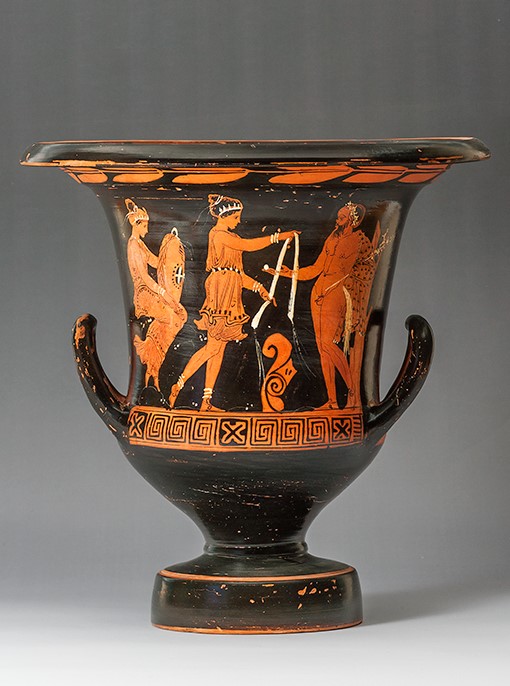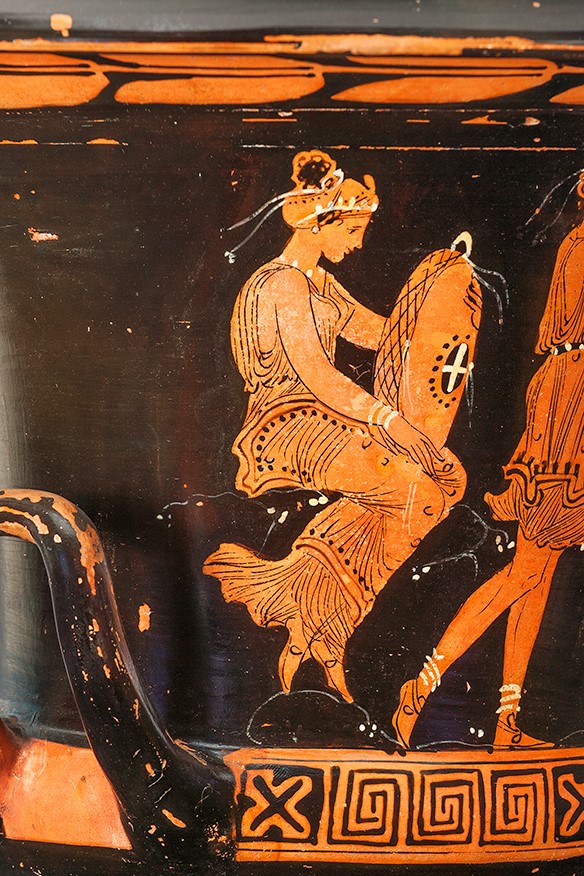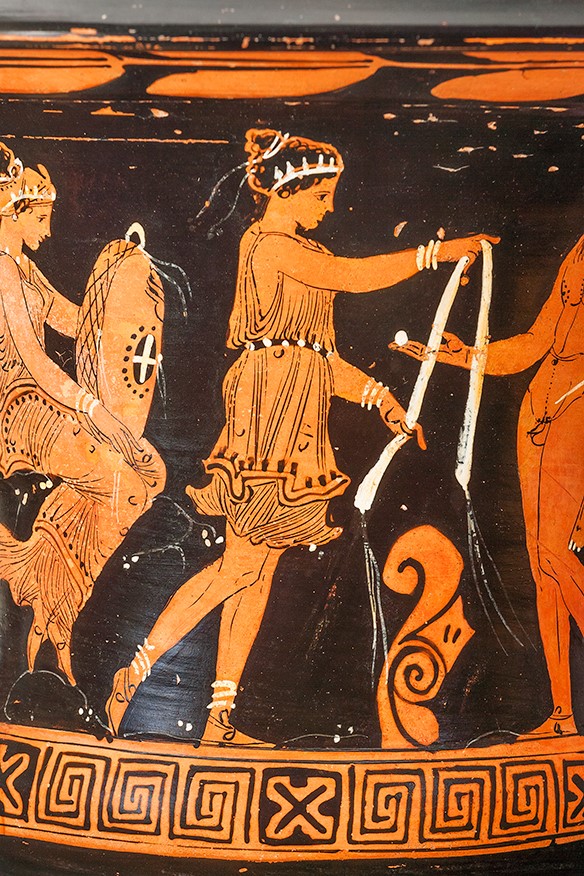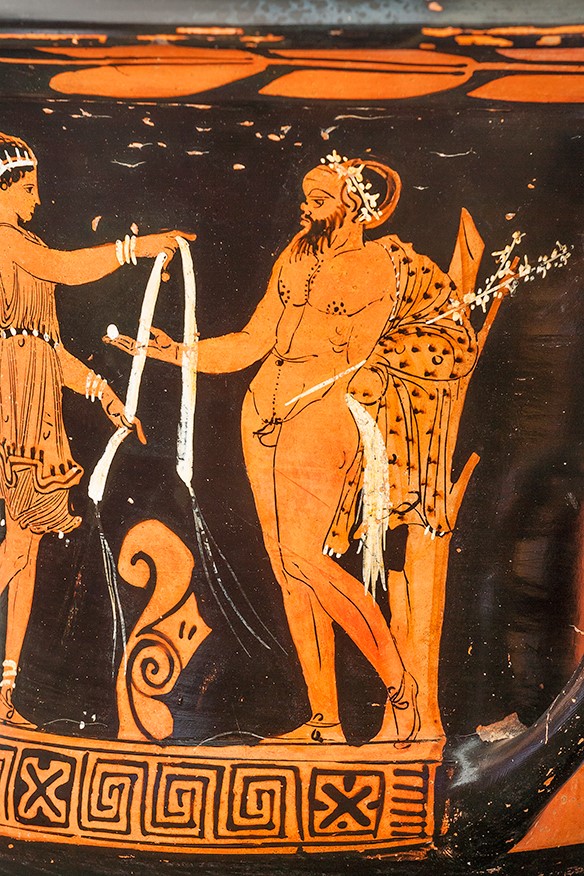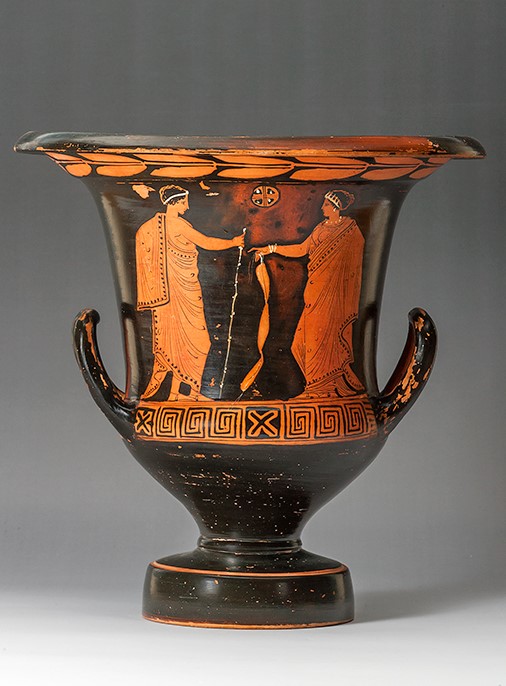Acquisition number: 1983.01
A: satyr and maenad, with another maenad seated to the left. The satyr leans against a tree, his left leg relaxed. He wears shoes or sandals and has a cloak wrapped around his left arm and shoulder; it has a thin brown wash, a white fringe below, and an edging of white dots by his chest. With his left arm he supports a branch and he has an ivy-wreath about his head, both of them done in white with a yellow wash over. His rather full tail is given the same treatment. The tree has strokes of a thin brown wash on left and right, to give it roundness.
B: youth and young woman. The youth and woman stand before each other. He wears a heavy himation with dotted border gathered over his left shoulder, and shoes on his feet. He has a wreath about his head and he holds a knotted staff (drawn in white and washed yellow) with his right hand. The woman stands before him holding out a sash. It is given a white edge (now mostly faded) and white tie-strings. She wears a chiton and himation with dotted border which is gathered over her left shoulder, and shoes. She has her hair bound with a band. She also wears a diadem, earring, necklace and a spiral bangle on her wrist. They are drawn in white with yellow wash (so as to appear gold). In the field above, a ball.
Title: Calyx-Krater - 1983.01
Acquisition number: 1983.01
Attribution: Painter of Louvre K 236.
Author or editor: J.R. Green
Culture or period: Campanian Red-Figure.
Date: c. 380-370 BC.
Material: Clay - Terracotta
Object type: Vessels - Krater
Dimensions: 375mm (w) × 366mm (h)
Origin region or location: Italy
Origin city: Campania.
Display case or on loan: 8
Keywords: Campanian, Red Figure, Satyr, Maenad, Painter of the Louvre K236, Sir William Hamilton, Sir Francis Hope
W. Tischbein, A Collection of Engravings from Ancient Vases .... now in the possession of Sir William Hamilton, IV (Naples 1795) pl. 35; E.M. Tillyard, The Hope Vases (Cambridge 1923) no. 260, pl. 35; A.D. Trendall, “Early Paestan Pottery”, Journal of Hellenic Studies 55, 1935, 39 fig. 2; id., Paestan Pottery (London 1936) 11 no. 9, fig. 7; id., “Paestan Pottery. A Revision and Supplement”, Papers of the British School at Rome 20, 1952, 3 no. 10; A.D. Trendall, The Red-figured Vases of Lucania, Campania and Sicily i-ii (Oxford 1967) 211 no. 62; The Red-figured Vases of Lucania, Campania and Sicily Suppl. iii (London 1983) 101 no. 62; Sotheby Parke Bernet, Sale Cat., 9 December 1981, no. 204 (ill.); Charles Ede Ltd (London), Greek Pottery from South Italy, 400-250 BC (1983) no. 6 (ill.); A.D. Trendall, The Red-Figured Vases of Paestum (London 1987) 36 no. 64, pl. 7d-e.
1983.01
Calyx-Krater
Ht ca 36.6cm; diam. lip 37.5cm. Formerly in the collection of Sir William Hamilton and, later, Lord Francis Hope.
Intact and in good condition but for a chip from the underside of the lip on the front right. The lip is somewhat uneven. A hole in the floor of the vessel has been filled.
Somewhat orange-brown clay without prominent inclusions. The lip zone is somewhat offset above and below. There is a step to the cull at the base of the wall. The handles are slightly in-turned and are of circular section. There is a fillet between stem and foot. A grooved step marks the shoulder of the foot.
Good lustrous black glaze, slightly flaked in some areas. There is some misfiring on the upper face of the lip and on the right side of the scene on the reverse. The resting surface and the underside are reserved, as is the groove at the shoulder of the foot. On the inside of the vase there is a reserved band just within the lip and another as the lip moves into the wall. The reserved areas are reddened on the outer and upper faces but not the underside.
On the outer face of the lip, laurel, left, with a reserved band above.
A: satyr and maenad, with another maenad seated to the left. The satyr leans against a tree, his left leg relaxed. He wears shoes or sandals and has a cloak wrapped around his left arm and shoulder; it has a thin brown wash, a white fringe below, and an edging of white dots by his chest. With his left arm he supports a branch and he has an ivy-wreath about his head, both of them done in white with a yellow wash over. His rather full tail is given the same treatment. The tree has strokes of a thin brown wash on left and right, to give it roundness.
With his right hand the satyr holds an egg forward towards a maenad who offers a sash or perhaps, rather, a wool fillet to him with both hands. It is painted in white with yellow over, and has long tie-strings. The maenad wears light shoes, spiral bangles about both ankles and wrists, a radiate stephane (or diadem) on her head and has her hair tied with a ribbon at the back; all these except the shoes are done in white, the bangles with yellow over (so they might be thought of as gold). She wears a short chiton with overfall and held with a white-dotted belt round the waist.
Her companion sits behind her on a rise in the ground. The hillock is shown by lines of white, now mostly faded but clearly detectable on the vase, and her toes also rest on the ground. A white groundline also comes forward under the central figure’s feet, and one sees it again before the satyr’s right foot. The clusters of two and three white dots represent the flowers in the meadow.
She wears a chiton and a wrap with dotted edge about her thighs and legs, and has her hair bound in a kekryphalos; it is tied at the back with a white ribbon and there is a small stephane (or diadem-like wreath) at the front. The last is white with yellow wash; so too are her earring, necklace and the spiral bangle on her right wrist. She holds a tympanon (or large tambourine) on her knee. It is decorated in the centre with a white cross and has four sets of white tie-strings.
Between the satyr and the standing maenad is a floral motif. Below the scene, on the cull, meander in groups of three with saltire squares between, and a filler at the right-hand end.
There is no trace of preliminary sketch. The drawing of the figures is done in a good, consistent relief line. There is no regular use of relief contour except at the backs and fronts of the necks of the figures, on the upper side of the seated figure’s right arm and the back of her right leg, and on the front of the satyr’s right leg.
B: youth and young woman. The youth and woman stand before each other. He wears a heavy himation with dotted border gathered over his left shoulder, and shoes on his feet. He has a wreath about his head and he holds a knotted staff (drawn in white and washed yellow) with his right hand. The woman stands before him holding out a sash. It is given a white edge (now mostly faded) and white tie-strings. She wears a chiton and himation with dotted border which is gathered over her left shoulder, and shoes. She has her hair bound with a band. She also wears a diadem, earring, necklace and a spiral bangle on her wrist. They are drawn in white with yellow wash (so as to appear gold). In the field above, a ball.
Below the scene, on the cull, meander in groups of three with salture squares between and a filler on the right in a scheme similar to the arrangement on A but with one square less.
In view of the sash held by the woman, the scene on the reverse may be funerary. One may then compare the scene on the obverse where the maenad offers a sash to the satyr who offers an egg (a common funerary offering) in return.
The maenads on the front have their heads slightly lowered, in a gesture of modesty that was regarded as proper to young women in Greek society: contrast the satyr. One may also note the use of shading on the tree at the right to give a three-dimensional effect.
This is a vase of good quality and is an example of the work of one of the Sicilian artists now known to have been responsible for setting up the first Campanian workshops in the area of Capua. On the basis of the very different illustration in Tillyard, the vase was originally attributed to the Dirce Group, but later given to the near-contemporary Revel Painter (A.D. Trendall, The Red-figured Vases of Lucania, Campania and Sicily i-ii [Oxford 1967] 211 no. 62). An examination of the vase itself in 1981 enabled Trendall to establish that his first thoughts had been correct and to narrow the attribution to one of the members of the Dirce Group, the Painter of Naples 2074 (The Red-figured Vases of Lucania, Campania and Sicily i-ii, 204-207). This re-attribution is discussed in The Red-figured Vases of Lucania, Campania and Sicily Suppl. iii, 100. On the basis of further evidence, he later transferred the piece to the Painter of Louvre K 236, who again has close links to Early Paestan. (For a summary and discussion, see A.D. Trendall, The Red-Figured Vases of Paestum [London 1987)] 34-35.) The clay is certainly Campanian rather than Sicilian.
The drapery of the figures on the reverse looks forward directly to that done in a more heavy-handed way in Paestan.
On the collections and archaeological activities of Sir William Hamilton (perhaps better known popularly for his wife Emma’s relationship with Lord Nelson), see the catalogue of the exhibition at the British Museum, I. Jenkins and K. Sloan, Vases and Volcanoes. Sir William Hamilton and his Collection (London 1996). He was Ambassador to the Court of Naples in the latter half of the eighteenth century and through his collecting of antiquities, responsible for much of the development of interest in the archaeology of the ancient world in Britain. See P. Greiner, Le antichità etrusche, greche e romane (1766-1776). La prima collezione Hamilton (Rome 1992); C. Knight, Hamilton a Napoli (Naples 1990); N.H. Ramage, “Sir William Hamilton as Collector, Exporter, and Dealer: The Acquisition and Dispersal of his Collections”, American Journal of Archaeology 94, 1990, 469-480. His collections lie at the core of the Greek and Roman collection in the British Museum: The Hamilton Collection. A Bicentenary Exhibition, 18 August - 29 October 1972 (British Museum, London 1972). On the Hope Collection, see E.M. Tillyard, The Hope Vases (Cambridge 1923).
About 380-370 BC. One may guess that this vase was found in Campania.
W. Tischbein, A Collection of Engravings from Ancient Vases .... now in the possession of Sir William Hamilton, IV (Naples 1795) pl. 35; E.M. Tillyard, The Hope Vases (Cambridge 1923) no. 260, pl. 35; A.D. Trendall, “Early Paestan Pottery”, Journal of Hellenic Studies 55, 1935, 39 fig. 2; id., Paestan Pottery (London 1936) 11 no. 9, fig. 7; id., “Paestan Pottery. A Revision and Supplement”, Papers of the British School at Rome 20, 1952, 3 no. 10; A.D. Trendall, The Red-figured Vases of Lucania, Campania and Sicily i-ii (Oxford 1967) 211 no. 62; The Red-figured Vases of Lucania, Campania and Sicily Suppl. iii (London 1983) 101 no. 62; Sotheby Parke Bernet, Sale Cat., 9 December 1981, no. 204 (ill.); Charles Ede Ltd (London), Greek Pottery from South Italy, 400-250 BC (1983) no. 6 (ill.); A.D. Trendall, The Red-Figured Vases of Paestum (London 1987) 36 no. 64, pl. 7d-e.
